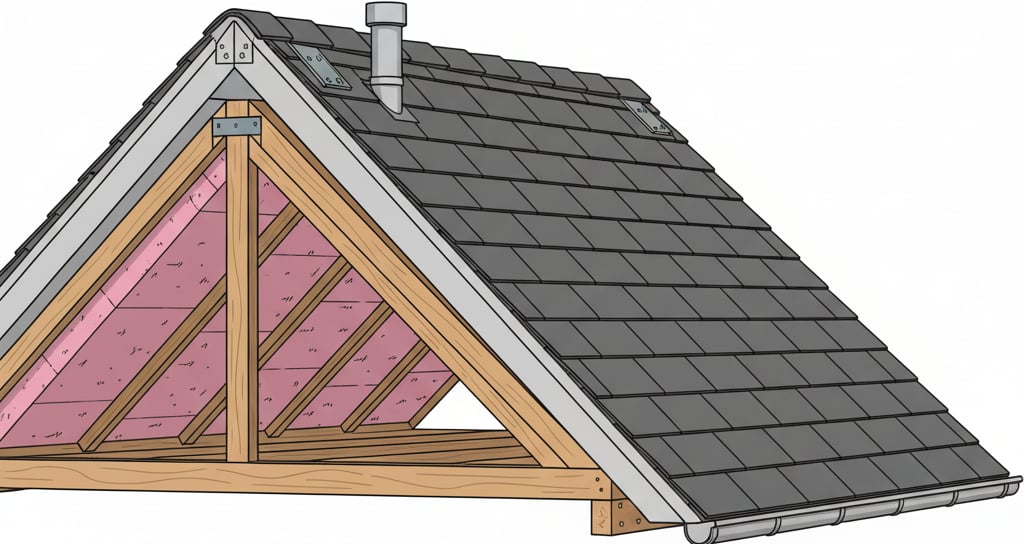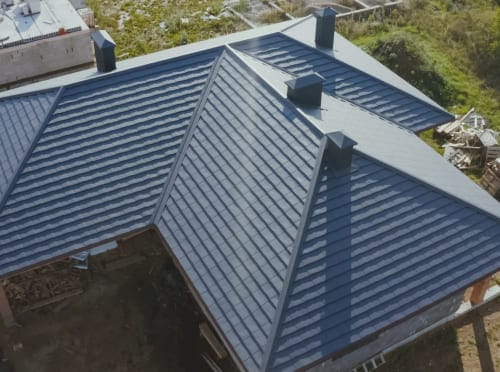Your roof is more than just shingles — it’s a complete system designed to protect your home from the elements. At JP Carroll Roofing, we’ve worked on thousands of homes across Connecticut and Massachusetts, and one thing we’ve learned is that homeowners feel more confident when they understand how their roof works. Knowing the key components of your roof helps you spot problems early, communicate clearly with contractors, and make informed decisions about repairs or replacements.
The Roof Decking
At the very base of your roof system is the roof decking (sometimes called sheathing). Usually made of plywood or oriented strand board (OSB), the decking provides the structural foundation for your roofing materials.
- Purpose – Supports the shingles and underlayment.
- Common Issues – Water damage, rot, or warping caused by leaks or poor ventilation.
- Why It Matters – Damaged decking must be replaced during a roof replacement to ensure stability.
Underlayment
Placed directly on top of the decking, the underlayment is a protective barrier between the wood and your shingles. It’s typically made from felt or synthetic materials.
- Purpose – Provides a waterproof layer and adds protection against leaks.
- Common Issues – Tears or deterioration over time, especially after storm damage.
- Why It Matters – A high-quality underlayment is your roof’s second line of defense against Connecticut’s heavy rains and snow.
Shingles or Roofing Material
The most visible part of your roof, shingles (or other roofing materials) provide the first barrier against the elements.
- Asphalt Shingles – The most common option, available in many colors and styles.
- Slate Roofing – Durable and timeless, often seen on historic homes in New England.
- Metal Roofing – Long-lasting and energy-efficient, ideal for storm-prone areas.
- Flat Roofing (TPO, EPDM) – Common for commercial buildings in towns like Mansfield and Windham.
Your choice of material depends on budget, style, and performance needs.
Flashing
Flashing is thin metal installed around vulnerable areas of your roof, such as chimneys, skylights, valleys, and vents.
- Purpose – Directs water away from joints and prevents leaks.
- Common Issues – Rust, cracking, or separation during storms.
- Why It Matters – Damaged flashing is one of the leading causes of roof leaks in Connecticut and Massachusetts.
Ventilation
Proper roof ventilation ensures that air flows through your attic, balancing temperatures and reducing moisture.
- Purpose – Prevents condensation, mold growth, and ice dam formation.
- Types – Ridge vents, soffit vents, and gable vents.
- Why It Matters – Good ventilation extends the lifespan of your roof and helps control energy costs.
Insulation
While not technically part of the roof itself, insulation in your attic works hand-in-hand with your roof system.
- Purpose – Keeps your home warm in winter and cool in summer.
- Common Issues – Gaps or insufficient coverage, leading to higher energy bills.
- Why It Matters – Strong insulation prevents ice dams and improves efficiency.
Gutters and Downspouts
Your roof system isn’t complete without gutters and downspouts to direct water safely away from your home.
- Purpose – Protects siding, foundations, and landscaping from water damage.
- Common Issues – Clogs from leaves or debris, sagging, or leaks.
- Why It Matters – A clogged gutter can cause roof leaks, ice dams, and basement flooding.
Skylights
For many Connecticut and Massachusetts homeowners, skylights are a desirable roof feature.
- Purpose – Bring natural light and ventilation indoors.
- Common Issues – Leaks caused by improper installation or aging seals.
- Why It Matters – Professional installation from JP Carroll Roofing ensures long-term performance.
Chimney Flashing & Seals
Chimneys are a common feature in New England homes, but they also create one of the most vulnerable spots on your roof.
- Purpose – Flashing and sealants keep water out at the chimney base.
- Common Issues – Cracked mortar, rusted flashing, or gaps that allow leaks.
- Why It Matters – Regular inspection and maintenance protect against costly water damage.
Why Knowing Your Roof’s Anatomy Matters
Understanding these components gives you the ability to:
- Spot problems early, like missing shingles or sagging gutters.
- Ask informed questions when working with contractors.
- Prioritize preventative maintenance.
- Protect your investment with smarter decisions about repairs or replacements.
Why Homeowners Trust JP Carroll Roofing
For decades, JP Carroll Roofing has helped homeowners across Connecticut and Massachusetts understand, maintain, and upgrade their roofs. Here’s why our customers choose us:
- Expertise Across All Systems – From asphalt shingles to flat roofing, ventilation to gutters.
- Regional Knowledge – We understand how Nor’easters, snow loads, and coastal storms affect New England roofs.
- Comprehensive Services – Roof repairs, replacements, siding, skylights, gutters, and more.
- Trusted Reputation – Known for honest pricing, dependable service, and skilled craftsmanship.
Keep Your Roof System Strong
Every component of your roof plays a role in protecting your home. By understanding the anatomy of your roof and scheduling regular inspections, you’ll ensure it performs at its best for years to come.
Call JP Carroll Roofing today for a professional inspection and keep your entire roof system strong and reliable.
Protect your home with trusted roofing from JP Carroll Roofing — serving Connecticut and Massachusetts with pride.


